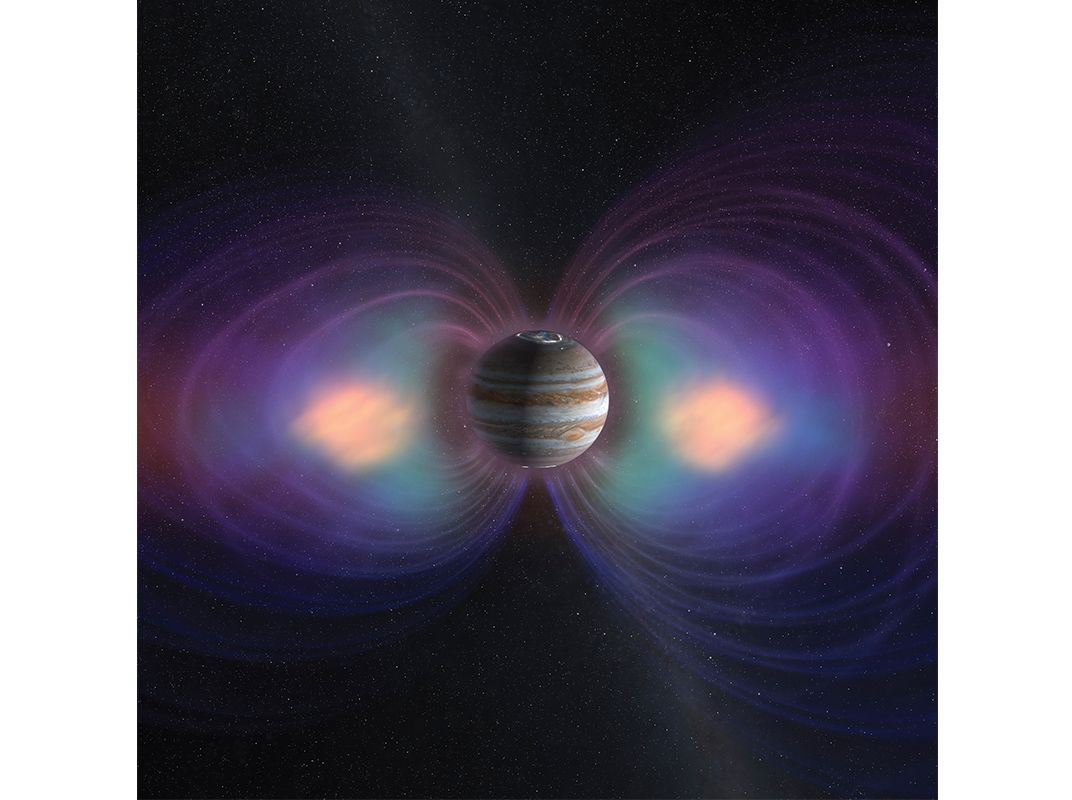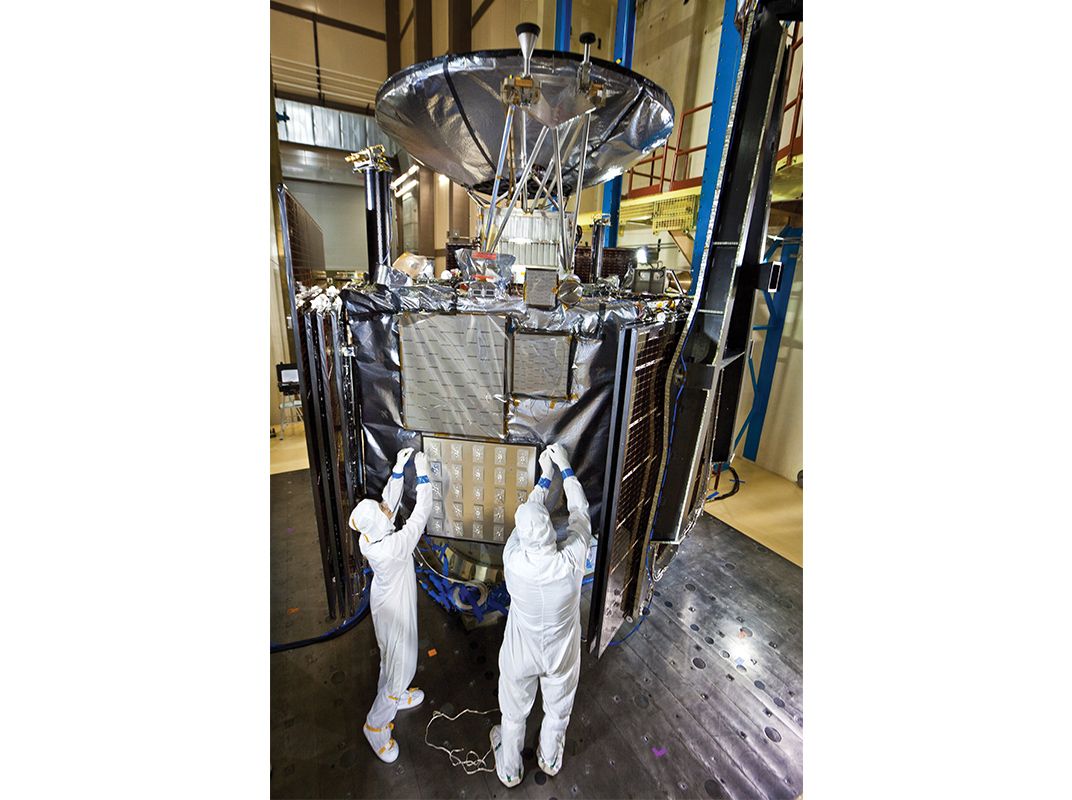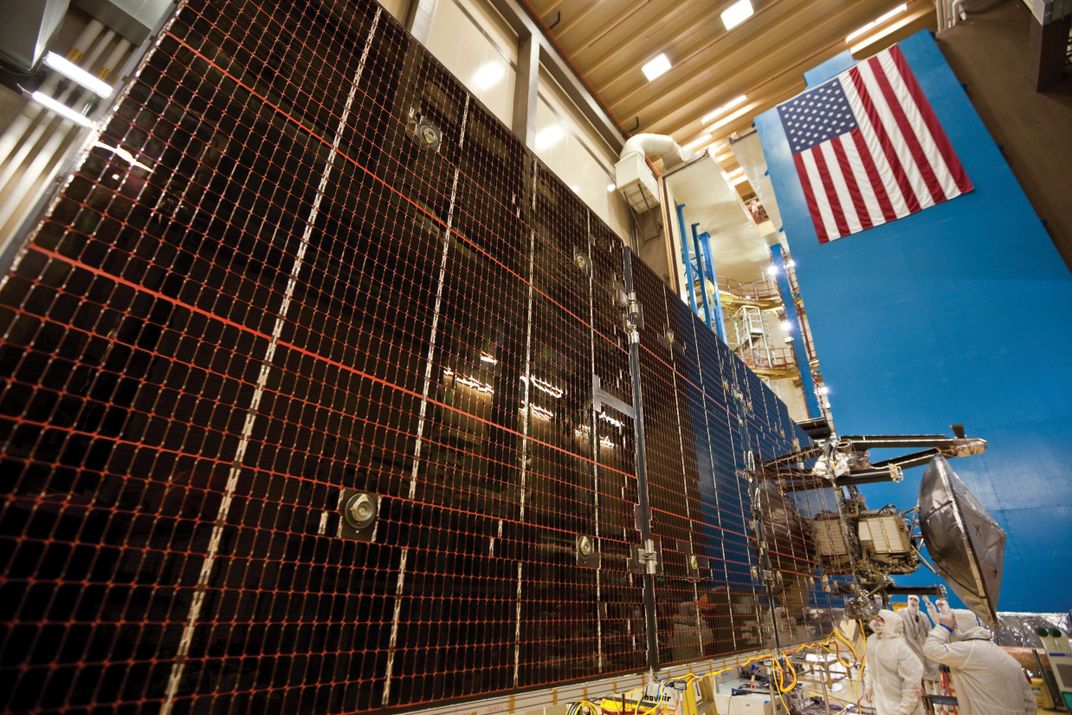To Dare the Realm of Jupiter
A spacecraft does battle with the giant.
/https://tf-cmsv2-smithsonianmag-media.s3.amazonaws.com/filer/4d/7e/4d7efa8b-930d-4fdc-a6c8-802d4c61eea1/12c_aug2016_jupiter_live.jpg)
Last July 4, when the Juno spacecraft executed a death-defying dive over Jupiter’s north pole and plunged through the planet’s searing radiation belts to begin orbiting the gas giant, Juno’s science team leader, Scott Bolton, declared the mission “the hardest thing NASA’s ever done.” That’s saying something: The agency has done some pretty hard things recently. In 2012, it landed the one-ton Curiosity rover on Mars after a harrowing “seven minutes of terror.” Last year, a probe it had dispatched in 2006 virtually re-discovered Pluto as a first act on the spacecraft’s way to explore the nether regions of the solar system. But the engineering virtuosity required for the Juno mission’s success supports Bolton’s boast.
“Jupiter guards its secrets with very formidable weapons,” says Bolton, a planetary scientist at the Southwest Research Institute in San Antonio, Texas, who has studied Jupiter for 28 years, since he was a grad student at the University of California at Berkeley. “It’s physically the worst place in the whole solar system that you could go to, other than going into the sun itself. It’s got two very powerful punches: its radiation and its gravity.”
So the spacecraft could survive the twin threats, the mission team devised a host of protections, beginning with a highly elongated orbit, which minimizes the amount of time the spacecraft is exposed to the worst of Jupiter’s radiation.
Juno is flying closer to Jupiter than any of the other six spacecraft that have visited the giant planet in the past 42 years: Pioneer 10 and 11; Voyager 1 and 2; Galileo, which orbited Jupiter 34 times between December 1995 and September 2003; and Cassini, which flew by Jupiter in December 2000, during its journey to Saturn. Scientists want Juno in close so it can make precise measurements of the planet’s atmosphere and deep interior, data that will reveal its composition and origins, and may offer insight into the genesis of the solar system 4.6 billion years ago. When Juno arrived last July, it made a two-hour pass from the planet’s north to south pole that brought it within 3,000 miles of Jupiter’s roiling cloud tops. Then Juno sped away, taking 53.5 days to complete what scientists called a capture orbit, allowing the team a chance to calibrate the probe’s instruments and test the data-processing pipeline before the science orbits begin. The spacecraft dove back in for another close, two-hour pass on August 27, then flew back outside the planet’s radiation belts. When the second 53.5-day capture orbit is complete this month, Juno will transition to a 14-day orbit and get down to business. Every two weeks until the end of the mission, in February 2018, the spacecraft will dive in for a two-hour transit, then loop away and around. Even with the cleverly designed orbital track, Juno will be exposed to the most extreme radiation environment that any planetary explorer has experienced: over the course of its mission, a total of 20 million rad. (The amount of annual exposure to background radiation on Earth is less than one rad.)
Jupiter’s powerful radiation is what attracted Scott Bolton to study it in the first place. “I was just kind of excited about the idea of incredibly high-energy physics,” he says. “I used to play with making my own fireworks. When I was a kid, I did things… I’m just lucky I have all my fingers. So when I started to learn about Jupiter’s radiation belts—they have the most energy of anything I had come across because they had these electrons that were moving at near the speed of light. It was like, you know, ultra-relativistic.”
Bolton became part of the Galileo science team in the 1990s; that job and his experience on the Saturn-bound Cassini laid the foundation for Juno. In December 1995, Galileo dropped an atmospheric probe designed to measure the elements in Jupiter’s atmosphere—specifically, the abundance of carbon, nitrogen, sulfur, oxygen, and all the noble gases, the elements in the right-hand column of the periodic table, beginning with helium. “[The mission designers] knew that if you wanted to understand the formation of the solar system, you needed to compare the composition of Jupiter with that of the sun,” says Bolton. “Presumably, Jupiter is made from the leftovers of the sun, so why is it any different from the sun at all? Why isn’t it made of exactly the same stuff as the sun? Some scientists had already measured it remotely, and it seemed to be enriched in one element or another. And so [the Galileo team] was like, Okay, how did that enrichment happen?
“Nobody knew the answers. They thought basically that water ices had formed early in the solar system’s formation, and big snowballs managed to trap other elements, and when Jupiter formed, these things went in with the rest of the gas.”
The Galileo probe was expected to gather data to confirm or refine this theory. It transmitted for 57 minutes, before it was vaporized by the intense heat and pressure it encountered, and its data confused the scientists. The probe found that relative to the sun’s composition, the elements in Jupiter’s atmosphere were all enriched by precisely the same factor. “Carbon was three to four times the percentage that it was in the sun, relative to hydrogen, and so was nitrogen, and so was sulfur, and so was every noble gas,” Bolton says, enthralled by the mystery. “Everything was enriched, except the water! There was no theory that existed to explain that. And so in the short time that the probe went down into the atmosphere of Jupiter and returned its data, which was only 50 minutes or something, every theory of the solar system’s formation and planetary formation was proven wrong. There wasn’t a single theory left that could work.” The results that countered the snowball theory—that somehow elements were trapped in ice that was pulled into the planet as it formed—were among the most difficult to fathom. “The water was less than half of that measured in the sun,” says Bolton. “And they were like, Oh my god, not only can we not explain this enrichment, we can’t even use water ice to try to solve our problem. Which was profound.”
Bolton was a young scientist at the time and working at the Jet Propulsion Laboratory on another part of the Galileo mission, but he says he was very strongly influenced by the quandary the probe team members found themselves in. He attended meetings to discuss the probe’s results. “And I was startled that the scientists were at a loss. I’m like WOW. They don’t know what to do. I gotta go work on that!”
Not long afterward, he got the chance. Collaborating with Tobias Owen, then an astronomer at the University of Hawaii who led the U.S. science team developing the Cassini-Huygens mission, Bolton and JPL scientist Michael Janssen devised a way to use a radiometer for measurements that would reveal the amount of oxygen in Jupiter’s atmosphere. Owen and Bolton realized that getting a radiometer inside the radiation belts could determine atmospheric temperatures at different wavelengths and at different depths. Such a profile of temperatures would enable them to deduce the amount of water, and therefore oxygen, in the planet’s atmosphere. That knowledge would help Owen construct a theory—to replace those blown away by the Galileo probe’s data—about how the planet formed. To Owen and Bolton, the observation was important enough to be the basis of another entire mission to Jupiter. Eventually, NASA agreed; the determination of water abundance in Jupiter’s atmosphere became one of the chief drivers of the Juno mission.
The instrument taking the temperature reading, one of eight science instruments on Juno, is a microwave radiometer; it will probe beneath Jupiter’s cloud tops to a depth of about 342 miles, measuring the structure, movement, chemical composition, and temperature of Jupiter’s atmosphere. Steve Levin, JPL project scientist for Juno, says the Galileo probe taught planetary scientists “a lot about the layer just below the clouds, but it was only one spot. For Juno to follow up on that and move beyond that, we want to get a global view of Jupiter.” Juno’s polar orbit will accomplish that goal. Each time the spacecraft passes over Jupiter’s poles, the planet will have rotated beneath it. So Juno will travel over a different section of Jupiter during each science orbit and, by the end of the mission, will have mapped the entire planet.
Besides the critical information about the abundance of water in Jupiter’s atmosphere, the probe’s eight instruments will reveal what lies beneath the planet’s beautiful and violent bands of clouds, fill in detail about the sphere of metallic liquid hydrogen scientists believe lies at Jupiter’s core, and map its radiation and magnetic fields.

**********
Particle Storm
Around Jupiter, swarms of charged particles, including high-energy electrons that originate from solar winds and from volcanic eruptions on Jupiter’s moon Io, become trapped in intense radiation belts within the magnetosphere and are whipped up to nearly the speed of light (the high energies that first captivated Scott Bolton). And Jupiter’s magnetosphere is massive: It bulges up to two million miles toward the sun and extends like a windsock more than 600 million miles behind the planet—as far as the orbit of Saturn.
Heidi Becker, a radiation engineer for Juno who is leading the mission’s efforts at JPL to monitor the radiation environment around Jupiter and to protect the spacecraft from it, speaks confidently but with a sense of worry and of awe at what she’s up against. “You can imagine how violent a particle would be—traveling at the speed of light and colliding with electronics,” she says. When charged particles at these energies hit the spacecraft, they will create a shower of secondary electrons and photons. Electrons are knocked off the material that’s impacted, “creating babies and grandchildren from the high-energy electrons that entered in the first place.” The result: lots of electronic noise and corrupted data, and the possibility that the pummeled instrument will fail catastrophically.
Becker joined the Juno team during the mission’s proposal stage more than a decade ago, and her primary job then was to figure out how to build six star trackers for navigation and for Juno’s magnetometer so that they won’t be corrupted by Jupiter’s radiation environment. The star trackers feed star patterns to a computer that calculates the spacecraft’s location and orientation. Becker’s job was an important one. Lose your navigation, and you lose the mission.
Her task was complicated by the decision to stabilize the spacecraft by spinning it. Instead of using thrusters, momentum wheels, and a sophisticated computer algorithm to stay stable in three axes, Juno spins: at one revolution per minute on the way to Jupiter, two rpm during science operations, and five rpm during main engine maneuvers. The simpler design cut weight and complexity from Juno’s overall design, but it added to the complexity of developing Juno’s star trackers.
The primary challenge for Becker, however, was designing star trackers that could operate in Jupiter’s radiation environment. No spacecraft ever has. “There was no one I could talk to about it and ask advice about it,” Becker says, “and there was nobody to tell me, ‘This is how I did it.’ ”
Simulating the radiation environment on Earth isn’t possible, adds Bolton. “We can’t create that environment here,” he says. “We can’t even make a small piece of Jupiter.”
And so to approximate what Juno is expected to encounter, Becker and others on the Juno team tested components of the spacecraft at facilities around the world that work with radiation: nuclear accelerators, laboratories used to simulate nuclear blasts for submarines, even radiotherapy departments in cancer hospitals. “We’d come in with star tracker detectors, chilled to a low temperature such as we thought we’d operate in [during the mission], with a little refrigerator trailing behind us at midnight when all the patients were gone,” Becker says. “And then we had doctors helping us to verify that we were putting the right number of electrons on our detector as we were testing it.”
To build in a margin of safety, engineers designed the spacecraft and its instruments to operate in an environment with twice the amount of radiation expected in Jupiter’s magnetosphere, Bolton says.

**********
In the Vault
At the heart of Juno are the electronics that operate all the sensors and cameras and process the data they collect. To protect these from radiation, engineers at spacecraft builder Lockheed Martin constructed a large titanium crate into which they placed standard electronics boxes, akin to the boxes the company used on the Mars Reconnaissance Orbiter. The 400-pound titanium cube has walls nearly a third of an inch thick.
The vault design presented unique challenges, says Kevin Rudolph, spacecraft principal engineer at Lockheed Martin. In previous spacecraft, the critical command and data handling box has typically been installed off in a location by itself, because of the complex network of cables running into and out of it. The power distribution box is similarly placed in its own location. But with Juno, everything had to be placed inside the vault. It was like solving a Tetris puzzle, Rudolph says. “What we ended up doing was putting 10 pounds of groceries in a five-pound sack,” he says.
With all those electronics packed into a tight space, heat builds up, so the vault has louvers that automatically vent the heat into space while maintaining the radiation shielding.
Rick Nybakken, Juno’s project manager at JPL, says the spacecraft is designed to take a few licks. If radiation exposure temporarily knocks out computers onboard—a condition engineers call going to “blue screen”—Juno will keep on spinning, stay on course, and importantly, continue to point its pinwheeling solar arrays toward the sun to maintain electrical power.
“If the spacecraft flies through a particularly harsh radiation field and the main computer temporarily goes down, the spacecraft has been programmed to auto-restart within eight minutes,” says Nybakken. “We’ve designed the sequence to do that a couple of times if necessary.”
Even though Juno’s orbit is designed to minimize exposure to Jupiter’s radiation, scientists project that by the end of its mission, Juno will have been exposed to the equivalent of more than 100 million dental X-rays. The inside of the electronics vault, however, will be exposed to about 1/800th that amount. With Juno’s titanium vault, “we’re basically an armored tank going to Jupiter,” Scott Bolton says. Still, over time Jupiter’s intense radiation will take its toll. Jupiter is not a symmetrical sphere, but oblate—it bulges at the equator—so the gravitational pull that the planet exacts on the spacecraft will vary, and over time Juno’s orbit will be distorted. That distortion will bring Juno gradually deeper into the planet’s equatorial danger zone. As the mission proceeds, “we start to accumulate more and more long-term radiation dose,” Nybakken says. That’s the primary reason the science mission is expected to last only a little more than a year. “We could not carry the amount of rocket fuel needed to counter Jupiter’s gravity,” says Bolton. “So it’s a suicide mission; you’ve got to go in close to learn these secrets, so you last as long as you can.”
**********
Cold and Dim
The final challenge in exploring a nasty giant like Jupiter is its location. Juno will be flying in an environment where temperatures are –238 degrees Fahrenheit and where sunlight is only four percent of what it is at Earth. Unlike Pioneer, Voyager, Galileo, Cassini (which is now orbiting Saturn on an extended mission), and New Horizons (which flew by Pluto last summer), Juno does not generate electricity with nuclear power—or radioisotope thermoelectric generators. It relies on three massive arrays that extend nearly 30 feet from Juno’s hexagonal body and collectively hold more than 18,000 solar cells. Juno will be the first solar-powered spacecraft designed to operate so far from the sun. Like its radiation protection, its solar power system required bold engineering.
First, the instruments themselves were designed to consume very little energy. With all instruments running at operating temperatures, and all heaters operating to keep the propellant from freezing, the spacecraft needs 400 to 450 watts of electricity—less than many microwave ovens. The mission design also conserves energy: During each 14-day orbit, the science instruments will require full power for only the period of the closest swing—about two hours. Engineers have built in a 50- to 75-watt margin to ensure that the spacecraft has access to all the power it needs, so near the mission’s end, the solar arrays can actually provide a combined 500 watts of power. Because radiation is expected to degrade solar cell efficiency by 10 to 15 percent over the lifetime of the mission, the Lockheed Martin team built in a second margin of power, Rudolph says. At the beginning of the mission at Jupiter, the arrays will be able to generate between 550 and 575 watts.

The solar cells were supplied by Boeing subsidiary Spectro-lab, which has developed solar cells and panels for Mars rovers Spirit and Opportunity and for satellites in Earth orbit, including the International Space Station. Lockheed Martin’s Kevin Rudolph says that to ensure the quality needed, his team handpicked nearly 19,000 solar cells, and rejected in excess of 15 to 20 percent of the cells they tested.
Juno uses “ultra triple-junction gallium arsenide” cells, which offer an efficiency of 28 percent at 1 AU (astronomical unit, equal to the distance between the sun and Earth, about 93 million miles). The technology has become standard for Earth orbiting spacecraft, Rudolph says.
In these solar cells, layers of gallium and arsenic are tuned to particular wavelengths of light, and each layer captures a relatively narrow frequency band. “If you want to capture more light, you put on more layers and you tune each layer to a different frequency,” Rudolph explains. “A triple junction means we have multiple layers of gallium and arsenic on the cell, such that one layer captures low-frequency, infrared light, one layer captures higher-frequency blue light, and one layer captures the light in between. By capturing more light, you actually can get more power out of that cell.”
Juno’s solar panel technology was fixed a few years before launch in 2011, but according to NASA, it’s still considered 50 percent more efficient and radiation-tolerant than the silicon cells that were available for spacecraft two decades ago.
Juno’s arrays are designed for a Jupiter environment, a fact engineers had to consider, since Juno had to travel from Earth to the outer solar system. If all the arrays were turned on at 1 AU near Earth, they would generate 14 kilowatts of electricity—way more energy than the spacecraft’s electronics could handle, Rudolph says.
So Lockheed Martin designed three separate circuits distributed across Juno’s three arrays. A small circuit was used near Earth to provide Juno with up to 500 watts; then from 1.4 AU (about the distance of Mars) to 3.5 AU, a second, medium-size circuit was turned on to maintain up to 500 watts of power, as light from the sun dimmed. Finally, from 3.5 AU to Jupiter, a third, larger circuit was activated.
This configuration had never been designed before. Engineers needed to assess how each circuit would perform at a given temperature and light intensity, and within a given radiation environment—and ultimately how many cells each circuit should have in order to generate the needed electrical power at each stage of the mission. It took several years of extensive testing.
To get the most energy from its solar panels, Juno is designed to keep the panels facing the sun during most of its mission. On the way to Jupiter, it was almost never in shadow, and during its polar orbit around the planet, the sun and Earth will always be about 90 degrees to its right or left, says Rick Nybakken. Still, the solar panels will not always be pointing precisely at the sun; during downlinks to Earth, for example, Juno will have to turn slightly away from the sun. Two 55-amp-hour lithium-ion batteries will provide continual power during those periods.
Those slight turns will be commanded by controllers at JPL. Rudolph, who says in another life he would have designed race cars, is captivated by the idea that Juno is actually not as automated as other spacecraft Lockheed Martin has built. “When we want to turn, we have to, down here on the ground, develop a sequence and tell Juno to turn,” Rudolph says. “Juno is kind of like a manual transmission car. We have to drive it—push the clutch in and shift gears.” The final command is expected to be given in February 2018: Juno will be directed to start two of its reaction control thrusters to slow, sink, and burn up in Jupiter’s upper atmosphere. The controlled maneuver is intended to eliminate any risk of collision with Jupiter’s moon Europa, a high-priority target for future exploration, partly because it is encased in ice, which may conceal a water ocean below.
“In a lot of ways, when you look at the design of this mission, the spacecraft, the orbit, the instruments—it holds together in a unified way that to me at least is elegant,” says JPL’s Steve Levin. “We have an orbit that gets close in the right spot, a spacecraft that just spins around so every instrument gets its turn, and we’re able to collect all of this data without the need for complicated scan platforms or dividing it up and saying only some instruments can operate at certain times. We avoid a whole lot of complexity by having this simple, elegant design for how [Juno] does the measurements.”
No spacecraft could survive the heat, radiation, and pressure of a plunge into the clouds of Jupiter; instead, the Juno team has cleverly designed the spacecraft to take soundings over the course of its mission. A little more than a year from now, when Juno’s mission is complete, Jupiter will no longer be the solar system’s grand enigma. Instead, it will be the messenger of the solar system’s origin story.
/https://tf-cmsv2-smithsonianmag-media.s3.amazonaws.com/accounts/headshot/Bruce_Lieberman_Yosemite_Cropped.jpg.jpeg)

/https://tf-cmsv2-smithsonianmag-media.s3.amazonaws.com/accounts/headshot/Bruce_Lieberman_Yosemite_Cropped.jpg.jpeg)